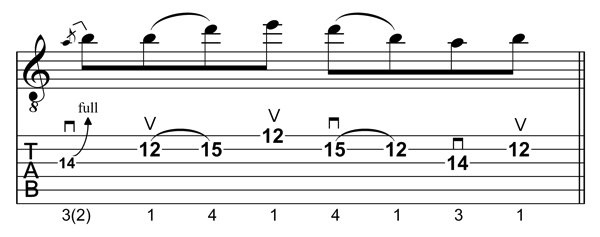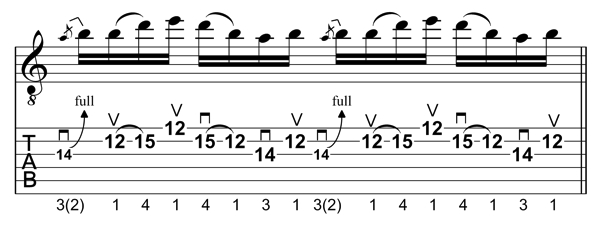I think we’ve all had the frustration of woodshedding a lick only for it to never appear in our soloing when we improvise. It can often feel like a waste of time to work so hard on something, only to notice that we can’t use it in our playing!
So what causes this problem?
Although there are quite a few possible reasons, a really common one I see all the time in my teaching happens when the student hasn’t practised the lick using different rhythms. They have just practised the lick one way only. And many times they have only practised the lick to a metronome click.
The problem with this is that real music isn’t as clear-cut as a metronome click. So even if you can play a lick effortlessly to a metronome, that doesn’t mean you can automatically use that lick in any real-life musical situation. When you start to improvise in different musical settings, you’ll soon discover that a lick that works really well over one rhythmic feel often won’t work verbatim over another rhythmic feel.
One of the best ways to solve this common problem is to practice licks using a wide variety of subdivisions. This can help you in the following ways…
- It helps you to improve your overall rhythmic ability and sense of time.
- It helps you to become rhythmically more versatile.
- It allows you to practice the lick in a way that will fit many more rhythmic feels. And this will make it much more likely that you can adapt the lick to a much wider variety of musical situations.
An Example Lick
To help you learn this practice technique, we’ll use the following example lick. But keep in mind that you could apply what we’re about to talk about to any guitar lick.
E Minor Pentatonic Lick:

AUDIO: Lick played at 50 bpm
AUDIO: Lick played at 100 bpm
This is a common pentatonic lick that is played using two notes-per-beat (i.e. eighth notes). If you haven’t learnt this lick before, then I recommend working on it now before moving onto the next part of this lesson. Once you can play it comfortably at a minimum of 100 bpm, then you’re ready for the next step.
Practising The Lick With Different Subdivisions
Now that you can play the lick as written, what we’ll do now is practice playing it with two other subdivisions…
- Eighth-Note Triplets. (This is when you play three evenly-spaced notes per click of your metronome).
- Sixteenth Notes. (This is when you play four evenly-spaced notes per click of your metronome).
Let’s now take a look at the lick written out using these subdivisions…
E Minor Pentatonic Lick: Played Using Eighth-Note Triplets (3 notes per beat)

AUDIO: Lick played at 50 bpm
AUDIO: Lick played at 100 bpm
Playing the lick as eighth-note triplets is deceptively challenging. The main reason for this is that each time you play the lick it begins in a different place rhythmically. If you look closely at the TAB and music above, you’ll notice the following…
- The first time you do the bend it starts on the first eighth-note triplet of the beat. This means that the bend will happen exactly when the metronome clicks.
- The next time you do the bend it happens on the third eighth-note triplet of the beat. This means that the bend occurs just before the metronome click.
- The last time you do the bend it happens on the second eighth-note triplet of the beat. This means that you need to do the bend just after the metronome click.
Because it’s quite hard to describe this accurately using text, it’s a good idea to listen to the audio recordings I have provided above lots of times.
E Minor Pentatonic Lick: Played Using Sixteenth Notes (4 notes per beat)

AUDIO: Lick played at 50 bpm
AUDIO: Lick played at 100 bpm
Even though we are playing four notes per beat for this variation of the lick, it is much easier from a rhythmic perspective to play than the previous variation. You’ll notice that each time you do the bend it happens when the metronome clicks. So, for most people, this will make it easier to play in time.
Applying The Licks
Once you can play the lick to a metronome click it’s essential to play the rhythmic variations over a wide range of backing tracks. The goal is to play all three variations one after another to see which one you feel works best for the track that you are playing over. Don’t focus too much on how the melody of the lick sounds. Focus mainly on the rhythmic aspect of the lick. [Side Note: Of course, it’s definitely a good idea to play the lick in the same key as the backing track. Otherwise, you’ll drive your neighbours insane!].
It’s a great idea to record yourself as you do this sort of practice. This way you’ll be able to listen back to what you’ve just played. And this will help you to notice more details, especially if you use software to listen to the recording at half-speed.
A Few Last Words
I hope you enjoyed this lesson. Once you’ve learnt to play all three variations of the lick, I recommend taking some licks that you currently know and experiment with playing them using different subdivisions.
It’s also really important to mention here that once you feel comfortable with playing licks using two, three and four notes per beat, then you might want to try using other subdivisions such as six and eight notes per beat.
Have fun!
Are You An Auckland Guitarist That Wants To Significantly Improve Your Electric Guitar Playing?
 If you're an Auckland guitarist wanting to improve your guitar playing, then my Auckland electric guitar lessons might be for you. I can help you to the develop technique, musicianship and mindset that will move you closer to how you truly want to play.
If you're an Auckland guitarist wanting to improve your guitar playing, then my Auckland electric guitar lessons might be for you. I can help you to the develop technique, musicianship and mindset that will move you closer to how you truly want to play.
To find out more about exactly how I can help you improve your playing, then download my latest Auckland guitar lessons info pack below...
